基于单片机的温室智能控制系统设计

1.无需注册登录,支付后按照提示操作即可获取该资料.
2.资料以网页介绍的为准,下载后不会有水印.资料仅供学习参考之用.
密 惠 保
基于单片机的温室智能控制系统设计(任务书,开题报告,论文14500字)
摘要
农业温室化是设施农业现代化的显著标志,对温室环境实行智能监测和控制是实现农业自动化的必要手段之一。计算机网络技术的发展和嵌入式技术的广泛应用,为温室智能控制提供的有效的方法和手段,通过结合农作物生长规律以及对环境条件的检测和处理,利用科学有效的方法对环境条件进行控制,可使得作物生产变得高质,高产,高效。
就温室而言,温、湿度是最重要的两个控制因素。本设计主要研究了对温室内温湿度的测量和控制的实现,包括系统的硬件部分设计和软件部分设计两个主要方面:硬件部分实现了对元器件的选型,相关电路的设计;软件部分包括下位机设计和上位机设计两方面,主要根据系统的设计要求画出流程图,并完成程序的编写和调试。
设计充分考虑了元器件性价比,在满足条件的前提下,尽量选用性能价格比相对较高的元器件。事实证明,该系统具有操作简易,性能稳定的优点,可实现对温湿度的显示、调节和控制,在相关领域具有一定的参考价值。
关键词:温室;温湿度;智能控制
Abstract
Agricultural greenhouse is an important symbol of the modernization of facility agriculture, and intelligent monitoring and control of greenhouse environment is one of the necessary means to realize agricultural automation.The development of computer network technology and the wide application of embedded technology of greenhouse intelligent control provides an effective method and means, through a combination of crop growth rule and test conditions and processing, using scientific and effective method to control the environmental conditions, can make the crop production of high quality, high yield and high efficiency.
[资料来源:http://think58.com]
In the greenhouse, temperature and humidity are the two most important controlling factors. This design mainly measures and controls the temperature and humidity in the greenhouse. It includes two aspects: the hardware part and the software part .hardwareof the system designincludes the hardware part and the related circuit design; the software part includes the design and the upper part of the lower machine. The design is based on system design, writing and debugging the program drawing flowchart.
The design fully considers the cost performance of the components and can choose components with relatively high cost performance under the premise of satisfying the conditions.
The practice shows that the system has the advantages of simple operation and stable performance, which can realize the display, regulation and control of temperature and humidity, and has certain reference value in related fields.
Key Words:greenhouse;Temperature and humidity;intelligent control
研究主要内容
[来源:http://www.think58.com]
本课题研究的主要内容是通过单片机极其辅助机构对温室环境进行智能化控制。主要是针对温湿度进行检测及控制。主要思想是传感器采集温湿度信息,然后通过单片机进行进一步 的处理和传输。在程序的控制下,微控制器根据预设和预期的控制要求通过显示装置进行显示和报警,同时可实现对温湿度范围的调节及相关控制。本课题的重点和难点是控制系统软硬件的设计。
主要研究内容包括:
1) 选择适宜的传感器并实现对应的数据信息获取、处理电路的设计;
2) 基于所选单片机为核心实现数据采集,数据处理及控制系统设计;
3) 设计并应用常用IO设备,完成键盘、显示等外设部分设计;
4) 通过USB转串口接口实现PC机与下位机的通讯;
5) 实现PID对系统的较为准确的控制;
6) 实现基于Proteus的温室智能监控系统整体仿真;
[版权所有:http://think58.com]
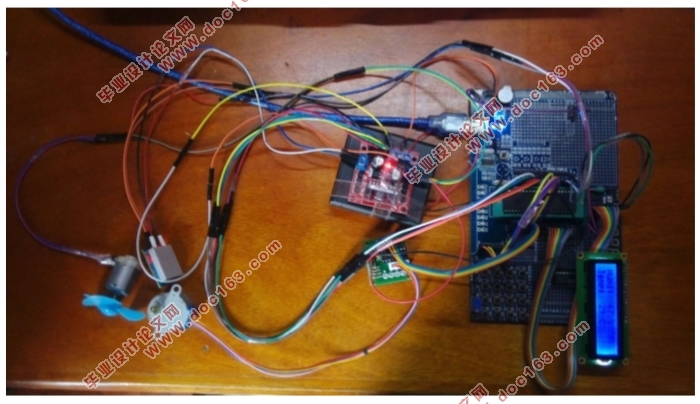
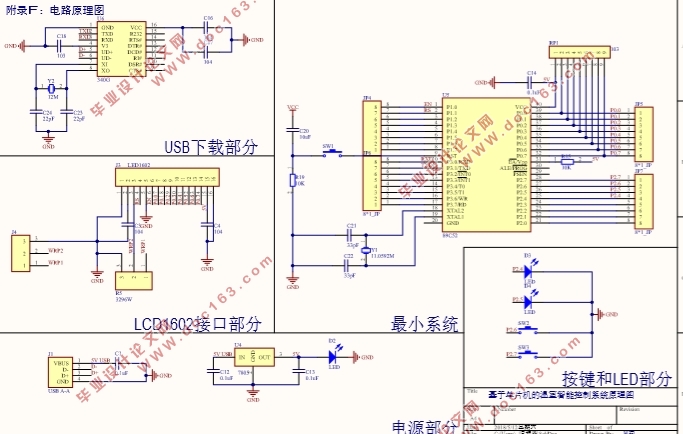
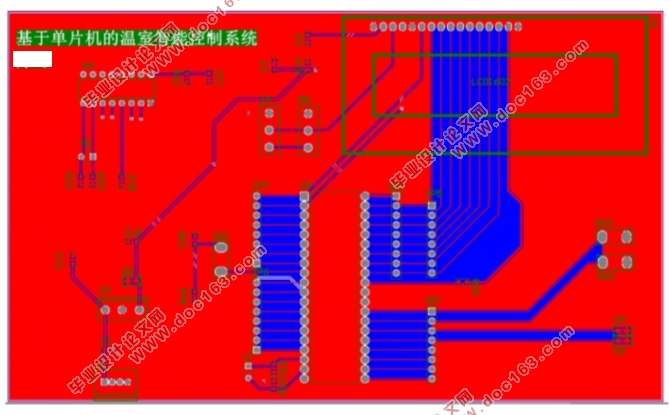
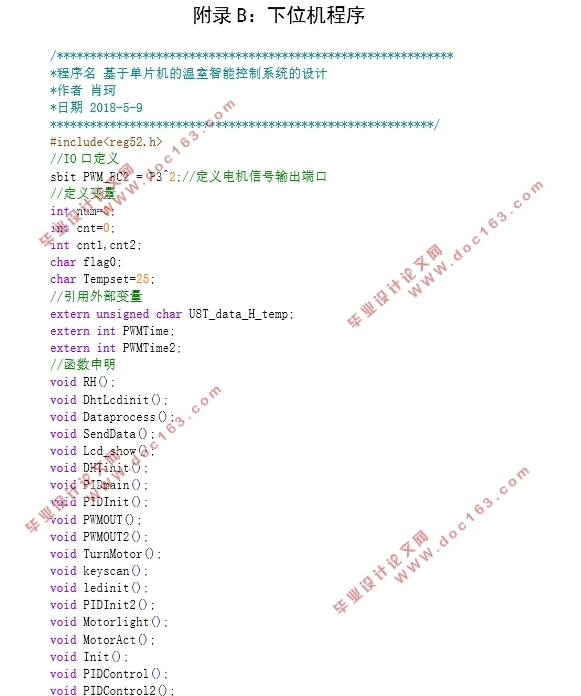
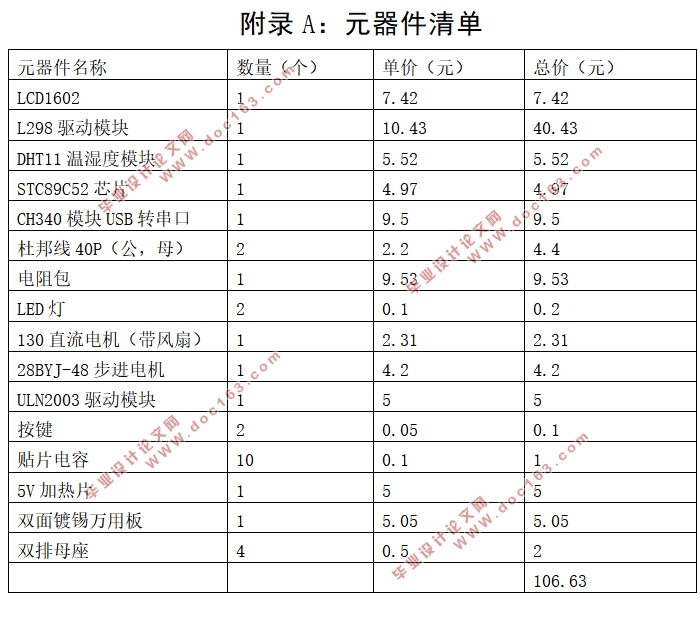
目录
第1章绪论 1
1.1研究背景与意义 1
1.2国内外发展现状 1
1.2.1国外发展现状 1
1.2.2国内发展现状 2
1.3研究主要内容 2
第2章系统总体设计思路 3
2.1硬件部分总体设计 3
2.2软件部分总体设计 4
第3章系统硬件部分设计 5
3.1硬件方案选择 5
3.1.1核心芯片选择与论证 5
3.1.2传感器选择 5
3.1.3显示模块选择 5
3.1.4电源方案选择 6
3.2系统硬件电路设计 6
3.2.1 STC89C52主控芯片介绍 6
3.2.2单片机最小系统设计 8
3.2.3液晶显示电路设计 9
3.2.4传感器模块电路设计 10
3.2.5驱动模块选择 13
第4章系统软件部分设计 15 [资料来源:http://think58.com]
4.1下位机软件部分设计 15
4.1.1编程平台简介 15
4.1.2 PID控制简介 15
4.1.3主程序设计 19
4.1.4 PID控制程序 20
4.1.5 PWM输出程序 21
4.1.6温湿度检测及串口发送部分程序 22
4.1.7显示部分程序设计 23
4.1.8下位机仿真平台介绍 23
4.1.9仿真模型搭建及演示 24
4.2上位机检测部分设计 24
4.2.1上位机搭建平台介绍 24
4.2.2主程序设计 24
4.2.3登陆界面设计 25
4.2.4上位机整体效果演示 26
4.3系统软件整体仿真效果 27
第5章系统实物调试 29
5.1下位机调试 29
5.2上位机调试 30
5.3整体调试 30
5.4调试结果 33
5.5现象分析及结论 36 [资料来源:http://think58.com]
第6章系统误差经济性及环保性分析 37
6.1系统误差分析 37
6.2系统经济性分析 37
6.3系统环保性分析 37
第7章总结及展望 38
参考文献 39
附录A:元器件清单 41
附录B:下位机程序 42
附录C:上位机程序 42
附录D:系统仿真图 42
附录E:实物图 42
附录F:电路原理图 42
附录G:PCB图 42
致谢 43
